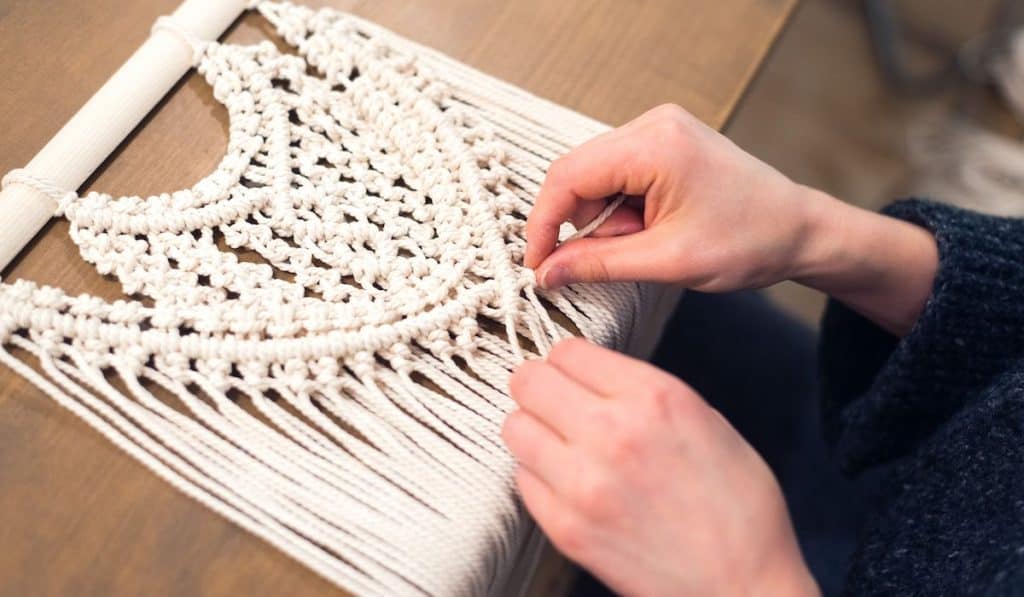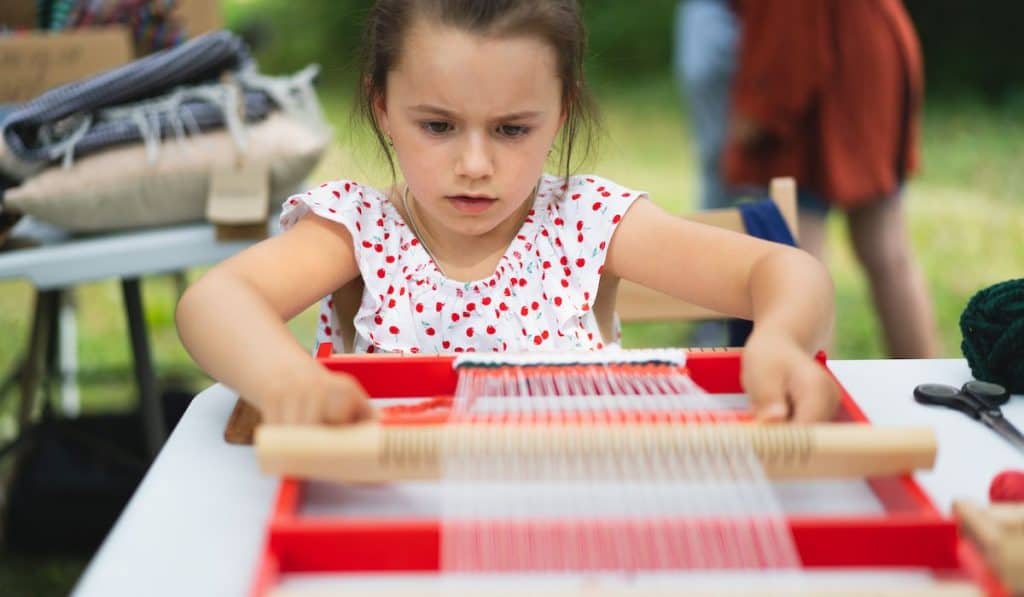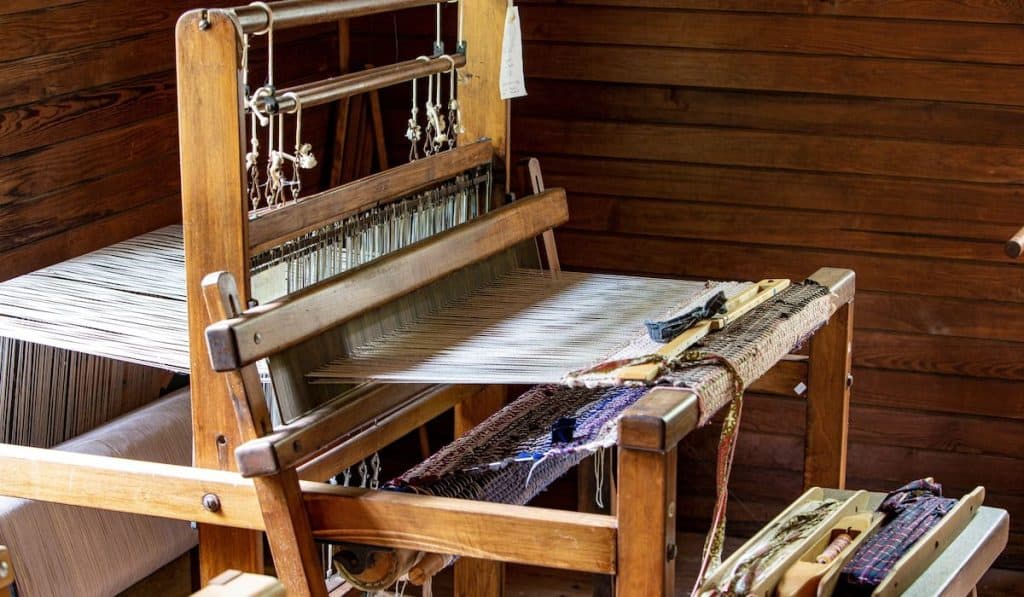If you are interested in a crafting hobby but don’t quite like the thought of paint and glue, weaving may be what you are looking for.
Whether you’ve been considering this for years or have never heard about weaving, you’re in luck today.
This guide will let you in on all you need to know about getting started as a weaver.
What Do Weavers Do?
Weaving is about creating weaves or tapestries by linking together yarn or fabric.
Using different specialized techniques, weavers combine color and design to create beautiful works of art.
When you are weaving, you interlace the different yarns at right angles to each other to create a pattern.
By focusing on the color and the design’s intricacies, you can make any pattern you choose.
Weaves can be used to make mats, pillowcases, wall hangings, scarves, and many other accessories.
Weaving doesn’t come in a single type; there are many options. For example:
- Rigid heddle loom weaving
- Square loom weaving
- Stick weaving
Just as there are several types, there are different design choices, patterns, and yarns to choose from. That makes weaving one of the most versatile crafts.
And that’s just one reason why weaving makes a great hobby. Here are many others:

Advantages of a Weaving Hobby
Suitable for busy people
For many people, finding the time for anything outside of work and chores is hard.
With this hobby, you don’t have to block out a lot of time at once. You can start, stop and then pick up right where you left off.
It’s, therefore, a good option if you can’t spare much time.
It takes your mind off things
Weaving is an absorbing hobby; it will have you so focused you won’t have time to think about anything else.
Ever been lost in something; your mind blocks out everything else around you?
That’s precisely the feeling you will get when you are busy weaving.
Improves coordination
Once you get to know what you are doing, you won’t need to look very closely at your work.
Your hands will start doing the movement on their own, helping to improve your coordination.
One of a kind
When people think about crafting, they usually have images of sketchbooks and paint. It’s rare to see people with weaving looms.
This makes it a unique hobby. You’ll probably be the one to introduce it to your friends.
Thus, if you like the idea of becoming a guru in something, this could be your chance.
Creative Artwork
Not much of a painter? Or maybe all you can draw is a stickman? Well, that doesn’t mean you don’t have a creative bone in you.
With a weaving hobby, you can bring out your creativity in a bespoke way. There’s a wide range of design elements and styles you can try out.
There will be no limit to your creative genius.
Good for all ages
Whether you are 5 or 50, there’s a weaving technique suited to your age. You can start learning how to weave at any age.
If you are looking for a hobby that you can do with your kids or your mom, this hobby is perfect.
Introducing your children to hobby weaving is an excellent idea to help their brain development.
Learning to coordinate all the colors and designs will stimulate their minds.

Brain stimulation
The best way to keep your brain active as you grow older is to take on some mentally stimulating hobbies. Weaving will help to keep your mind busy.
The process of determining your warps and wefts takes a bit of brainpower.
That’s why weaving is a useful brain hobby.
Calming effect
Weaving has a calming, somewhat therapeutic effect.
Patiently combining your weaving materials is an excellent exercise in keeping your cool.
This will help you to stay calm when faced with explosive situations.
It’s also a meditative tool; once you learn how to do it, you can zone out and allow your hands to do the work while connecting with your inner self.
Warps and Wefts: Weaving Terminology Explained
If you are entirely new to weaving, all the different terms may sound confusing. You’ll hear weavers talk about warping and wefting a lot.
It sounds like gibberish if you are a total noob, but there’s nothing to it; there’s no need for your head to spin.
Here are some definitions of the words you will hear in weaving circles.
Warp
A warp is a thread that you put vertically on your tapestry.
Weft
The weft is your second thread, which goes in between your warp to create the design.
Shed
A shed is a space that separates the warp threads so that you can pass the weft through.
The shedding process is putting something, your finger or a rod, in between the warp threads.
That way, you can weave your weft in faster, and it makes the process easier.
Now you are up to speed with the basic weaving terminology. Ready to learn how to weave? Here’s how you can do that.
Learning How to Weave
You can choose to learn how to weave at home or a weaving school.
Depending on your schedule or willingness to interact with other people, you pick the option that works for you.
Is a school better than self-teaching?
If you opt to learn at a school, you can practice with a supervisor; that way, they will check your work, and you may learn faster.
Also, you get help or observe what the other students are doing until you catch on.
If you are on your own, you won’t be able to ask if there’s something you don’t understand.
However, learning on your own gives you the freedom to choose your style.
You get the ultimate creative choice to learn at your own pace and unleash your inner weaving guru.
How fast or slow you learn will depend on how many hours you are putting in and your passion.
Therefore, whether you choose home or school, you will do just fine either way.
Weaving schools
To get a school for weaving, search your local directory to see the ones around your area. It helps to pick a school near your area, so you reduce the commute.
You will find it easier to fit weaving into your daily schedule if you don’t have to go far to do it.
Before you enroll, it helps to check out the school’s reviews online. Find out if other people are raving about it.
If there are too many complaints, it would be best to steer clear of it.
Learn at home
If you decide learning at home is a better option for you, then get some resources.
You can find an online school and follow their course.
Check out these resources.
If the thought of a structured class doesn’t interest you, you can still find some help.
YouTube weaving videos should give you a good head start. If you type “weaving for beginners” in the search box, you’ll get plenty of videos to watch.
However, you have to remember that weaving is about the handy work, so watching without actually weaving doesn’t count as learning.
That’s why you have to put in the practice so you can learn.
The Beginner Weaver’s Tool Kit
Having the right supplies will make the learning process faster and help you enjoy your new hobby.
Here’s some of the equipment you will need for weaving.
A Loom
This is the frame that will give shape to your designs. It’s rigid enough to make it easy for you when you are warping and wefting – it doesn’t sound foreign now, does it?
Looms for weaving can be as small as 8 inches or as big as 60 inches. Depending on what you want to make, you can pick a loom of any size.
As a beginner, you can opt for the following types of frames.
Lap loom
This is a small loom frame that can fit on your lap, hence the name. Because of its size, it’s very portable.
You can do your weaving in any part of the house or elsewhere.
This one is perfect for the absolute beginner so that you can start small.
Once you get the hang of your new hobby, go for the bigger loom frame.
Standing table loom
The next option for beginners is the standing frame. This one is a lot bigger than the lap loom and can stand on the table.
An upright loom can be placed on the table and then weave without having to prop it with your arms.
As you get better at the craft, you can opt for bigger ones like the floor loom to make much bigger designs.
Still, you don’t have to limit yourself to one loom. You can get a loom in every size to cater to the many different projects you will work on.
How much will it cost? Well, loom prices vary over an extensive range. Most looms cost anything from $80 to $4400.
As a newbie, you don’t have to splurge on the more expensive ones just yet.
Start with the smaller and cheaper looms until you get the hang of it. Once you are a pro, you can get several other looms.

Where to Buy Looms
You can get your hands on a loom at several different stores, for example:
You’ll also get looms from online weaving schools. Another good option is to get a second-hand loom.
To find these, ask around your local weaving classes or look for a weaving guild near you.
If you are lucky, you may land a second-hand loom on Craigslist or eBay.
Yarn
You will need yarn to make your designs – one for the warping and then the other one for the weft.
For warping, the best option is a pliable but strong yarn. Pick any option as long as it is strong enough.
As a beginner, you may want to start with cotton yarn as it won’t break easily and is soft enough to work with.
Other types of yarns you can choose include.
- Acrylic
- Bamboo
- Hemp
- Wool
- Silk
- Rayon
- Polyester
Your warping yarn can be in any color. When you’re starting, it’s safer to choose plain bright colors like cream or white.
That’s because it will be easier to see what you are doing when you start wefting.
You will also need some yarn for your weft. Try and get a contrasting color for the weft. It will make your life easier when you are just starting. Moreover, working with bright colors is quite stimulating.
Buy your yarn from most online shops, on Amazon or Etsy. If you really want to get the most out of your crafting experience, go for plain threads, and then dye them.
That way, you can mix your colors for the yarn – your designs will be one of a kind.
Is it expensive? No, it doesn’t cost too much. Buy yarn from as little as $13 for 800 yards of yarn.
Prices can range to more than $50 if you go for the fancy types like acrylic.
Tapestry needle
Tapestry needles are big needles with large eyes. They are usually blunt at the end and don’t have a pointy end like a sewing needle.
They can be used for wefting or neatening the work so that you won’t have hanging pieces of yarn.
The needle’s size depends on the material you are working with and how big your design is.
Needles usually come in sets, and they are cheap. In some cases, you can pay less than $5 for a set on Amazon.
Shed stick
To open up your warp as you weave, you will need a shed stick.
This is simply a small wooden flat stick. These are readily available online or in your local stores.
Other accessories
You will need other small accessories like:
- Scissors – for cutting (you can use your kitchen scissors)
- Dowel – for removing and hanging your weave
- Shuttle – to thread faster
- Beater – to even out your work
As an absolute beginner, you don’t need to splurge on expensive tools. Buy most of the cheaper supplies so you can get started.
Is It Hard to Learn How to Weave?
With the right learning and work tools, it shouldn’t be too hard to learn.
Everyone is different; that’s why how fast or slow you learn is different for everyone.
Some will master the skill so quickly you’d think they were born with a weaving superpower. Others will take longer to learn.
Depending on your commitment and practice, you should soon get the hang of it.
The good thing about a weaving hobby is that it’s challenging enough to keep you on your toes.
At the same time, the repetitive nature of the threading makes it relaxing enough.
So even though it might be a bit hard when you start, keep trying.
Once you start creating your beautiful wall pieces or mats, you’ll be happy you stayed at it.

What If I Can’t Afford All This Equipment?
The largest purchase you will make for your weaving hobby is the loom. The good news is that even if you can’t afford it, you can still weave without one.
You can D.I.Y your loom out of materials you already have at home. Use an old cardboard or cereal box.
Another option is an old picture frame. You only need to put nails or pins right around it to hold your yarn.
Once your warp (vertical thread) is in place, you can weft your way to a pretty design.
Then gently lift the ends and neaten them, and voila, you have made a weave – no loom needed.
For smaller weaving designs like bracelets, you can hand weave. To do this, support one end of the yarn by tying several yarn threads into a big knot or tying it on to one leg of a chair.
This will be your warp. Next, you can thread in your weft using a needle or your hand. To make it sturdy, tie each weft to a warp as you go.
Tips for Beginner Weavers
Practice a lot
A weaving hobby makes for a fulfilling experience. All the more if you give it a bit of time.
That’s why it’s a great idea to practice a lot. Your first designs may come out wonky and bumpy, but you will enjoy making them.
And the more you keep at it, the better you become. Who knows, you might soon be selling a couple of pieces to your friends and family!
Finishing a weave
Make your weaves aesthetically appealing by giving them a neat finish.
You can use a tapestry needle to tuck loose threads at the back of your tapestry or make a stitch at the end.
Then cut off any loose hanging threads. The better it looks, the more you will feel the warm fuzzies over your creations.
Do your planning
Plan before you start on a weave. This will make it easier to coordinate your colors or styles.
Plus, you will know all the material you need beforehand. You wouldn’t want to ruin an exquisite weave when you run out of yarn.
Become part of a community
To learn from other weave enthusiasts, join a couple of online weaving communities. You will find a few of these on social forums like Facebook or Reddit.
Buy used equipment or ask about different techniques from other weavers.
It’s a great way to learn faster, create good stuff, and make a couple of new friends while you’re at it. Did I mention weaving is a great hobby?
Join a guild
Apart from becoming a non-committed part of an online community, become a member of a weaving guild near you.
You will learn from established weavers and access training and resources to turn you into a pro in no time.
When you need a new hobby, weaving is a great one to pick. There is a ton of amazing benefits and being part of a larger community of weavers is one.
Once you learn how to do it, you’ll be making creations you can be proud of.
And it will be fun confusing your friends with stories about warps and wefts and all things weaving – after gifting them with some beautiful weaves, of course!
Conclusion
Now that you have all the information required, go ahead and try your new hobby – you will soon get hooked on a fulfilling pastime.




